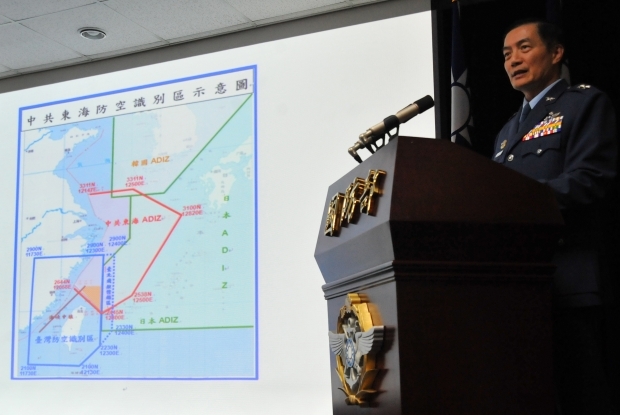The United States wants China to pull back from its gambit to try to rewrite the East China Sea’s status quo, but the Chinese are having none of it. On December 2, the U.S. State Department said China’s newly-declared air defense identification zone (ADIZ), a California-sized swath over the East China Sea that includes a disputed island chain the Chinese call the Diaoyu and the Japanese call the Senkaku, has “caused confusion and increased the risk of accidents.” U.S. Vice President Joe Biden sounded a similar warning while in Tokyo, before departing for Beijing this week.
Chinese have heard this argument before, and they are still not convinced. On November 28, a spokesperson for China’s Ministry of National Defense responded to a call from Japanese politicians demanding the same thing. After noting that Japan’s own ADIZ was established in 1969, the spokesperson added, with a good dollop of sarcasm, “If we are talking about rescinding, then we kindly ask Japan to rescind Japan’s own ADIZ first. China will consider [rescinding] in another forty-four years.” Xinhua, China’s state-run news agency, published a December 3 editorial that took a similar tone, accusing the government of Japanese Prime Minister Shinzo Abe of “pretending to be an innocent little bunny, exaggerating the threat, and spreading fear immediately after China declared the ADIZ.”
Online, the sentiment has been even sharper. In response to the U.S. and Japanese contention that China’s ADIZ is “unacceptable,” one user of Sina Weibo, China’s Twitter, asked, “Why are the ADIZs of Japan, the United States, and Korea acceptable?” Another sneered, “Chinese people also strongly urge Japan to remodel the Yasukuni Shrine into a toilet.” (The Yasukuni Shrine honors many Japanese war dead, including some World War II war criminals who operated in China.)
Many online comments seem to reflect a belief that China is engaged in an elaborate geopolitical dance with its rivals. One Weibo user noted that the two B-52 fighter jets the United States sent into China’s ADIZ on November 26 to flout the zone were unarmed, commenting that the action, and China’s declaration of the ADIZ, “is posturing.” He added that the real game “is being played behind the scenes” and “both parties understand where the boundaries are.” Another sensed weakness in the United States for urging its private airlines to comply with China’s ADIZ procedures, when Japan had not done the same: “The United States has sold out Japan halfway already. The Americans are pragmatists, and eventually they will accept the reality on the ground.”
But mistakes can happen: In 2001, a U.S. spy plane flying seventy miles away from Chinese borders collided with a People’s Liberation Army fighter jet, killing the Chinese pilot and setting off a diplomatic crisis.
If something similar were to happen, Chinese President Xi Jinping would likely find strong grassroots support from netizens, who see the ADIZ as a stand against hostile foreign forces. One Weibo user gushed, “This generation of leaders is so daring and capable. They are tackling corruption domestically, and they have stopped being cowards in the international arena. Applause.” Another agreed, “To hell with the United States and Japan! We may have objections about our government, but that’s a domestic matter. On issues of international affairs, I support the government without reservation. Finally, after so many years, we see a strong China!”
One way or another, U.S. diplomats and military personnel will have to reckon with this strain of defiance. Chinese leaders are responsive to public opinion, and, to some extent, beholden to it: Stronger objections from outsiders may have the unintended effect of forcing the Chinese government to dig in its heels to accommodate rising nationalism at home. The United States may still be able to get China to retrench, but it will have to rely on more than its persuasive powers alone.




